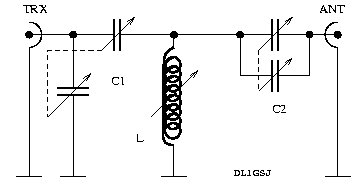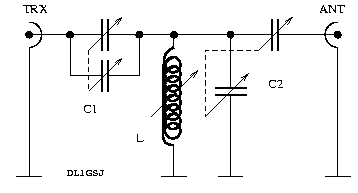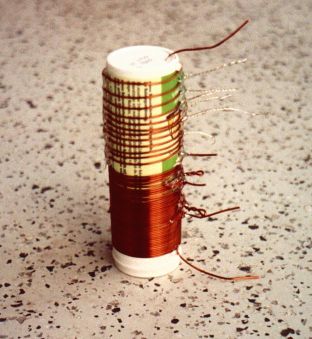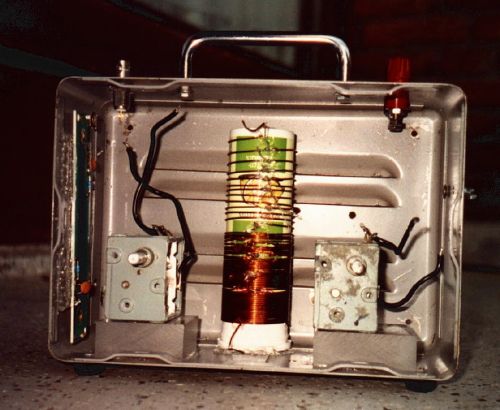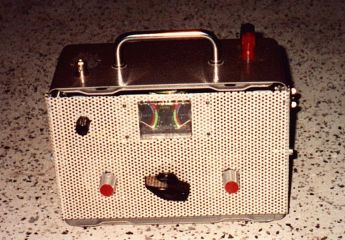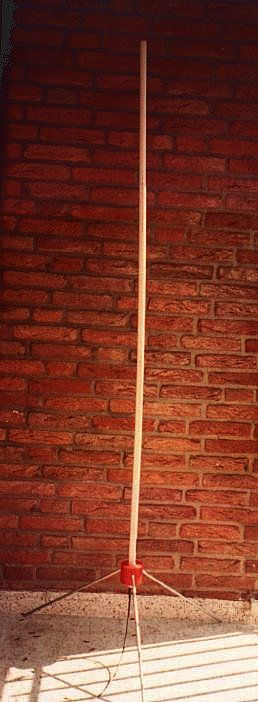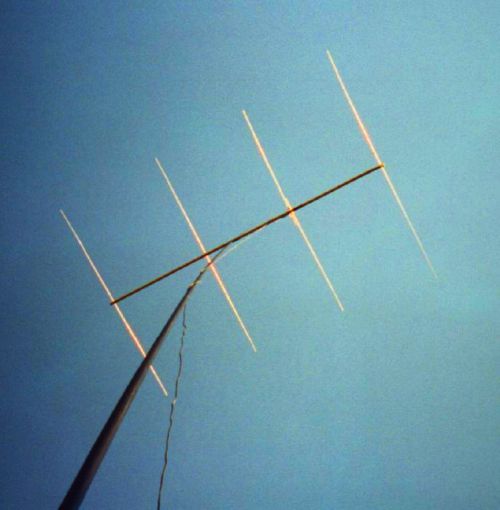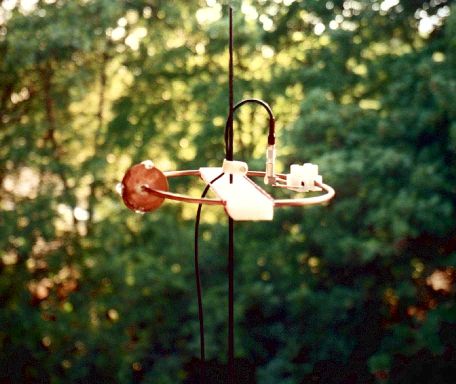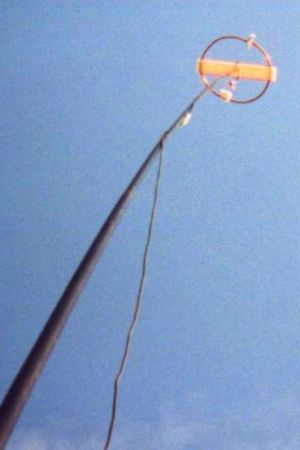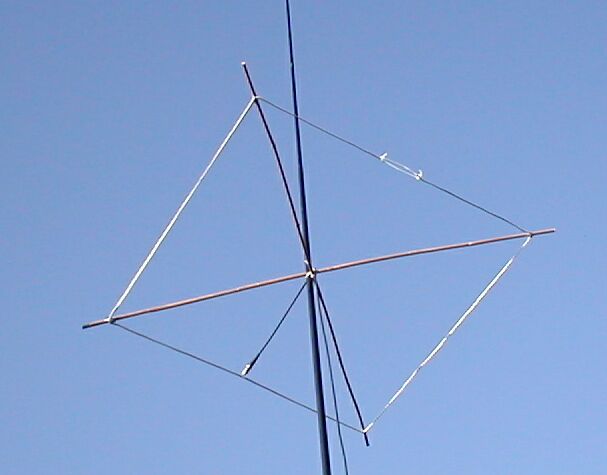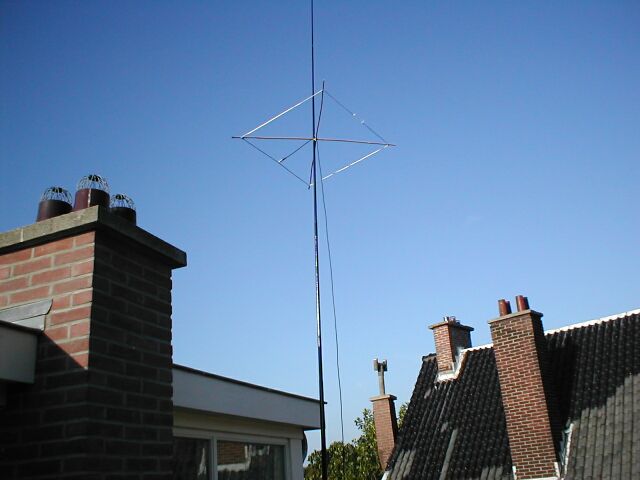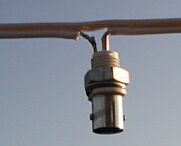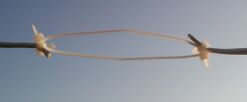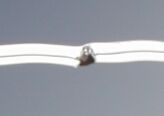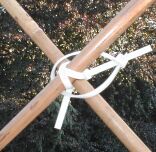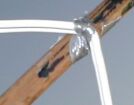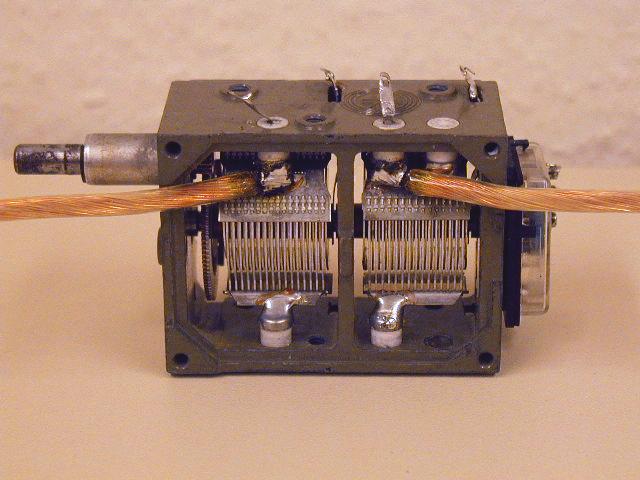The last few days, I experimented a bit with the flower pot heater... actually, I turned the one heater into two! All experiments were done whilst my central heating was set to "frost protection".
From a physics point of view, the 4 pots, as shown in the previous post, are a rather large thermal mass. And of course, physics does not lie. Despite the 4 candles, it took some time to build up noticeable radiant heat, which than lasted for quite a while. In this respect, the 4 pot solution is more of a constant heater than an "on demand" device.
At some stage, I removed one inner pot and tried with 3 pots bolted together. This has proven to be a little bit faster in heating up, satisfactory it was not. The mass of the big pot takes too long to warm up appearently.
The next experiment was to use the second to largest pot and the 2 smaller ones. I also removed the brick at the opposite end, since I noticed that the candles were not getting enough oxygen. Well, some improvement, but still not really up to scratch.
In the next iteration of experiments, I used only 2 pots, the smallest and the second to largest. Also, I reduced the amount of metal inside by using a shorter bolt. The reduced circumference of the setup allows for a smaller soucer to hold the candles. The bricks set flat now, the distance between the flame(s) and the thermal mass is reduced, speeding up the warm-up. Noticeable difference!
Some remark here, it seems that in particular when using more than 2 tealight candles, the soucer I used was filled up with cold CO2 so quickly that one candle always fainted. It seem that the heat-transfer is very effective, so effective that the CO2 fall straight down on the candle(s). When the setup is warmed up a bit, this effect is gone.
Radiant heat is kinda cool (warm that is), however, what about heating air? And yes, this works well, however, it slows down everything again. What works well, you may ask...
I used 4 candles in the 2 pot heater mentioned above and placed the big flower pot on top. Since this time the big pot is not connected to the bolt, the hole in the pot is open. Heat builds up between the bolted 2 pot setup and the outer loose pot, which due to the chimney effect is drawn upwards through the big pots hole. In the course of time, also the big pot heats up such that it radiates heat.
Such a setup creates heat by convection and at some later stage also radiant heat.
Latest experiment: two 2 pot heaters.
I believe you understand where I am going from here. The big pot was loose already, and the second to smallest was not used at all.
Some considerations about the 2 heaters I have presently available. The biggest pot will have a large thermal mass, which stores heat for a while. The smaller pots (less mass) will heat up fast and start radiating relatively quickly.
Since a couple of days I experimented successfully with the following scenario. The smaller heater is in my study, where I do stuff in the late afternoon, just when I returned to home. This room needs quick heating, so I use the smaller FP-heater with 2 or 3 TL-candles, to get radiant heating asap. At the same time, I would light a single TL-candle in the big pot heater to create a certain baseline warmth in my bedroom. Halfways into the evening/night, I might have to replace this single TL-candle with a fresh one. The big pot does not get very, it is warm to the touch at the top and cold at the lower side, however, my bedroom feels just right with this amount of heating.
Again, this is not radio related... sorry for that! However, I believe that this could be of some interest to some of my audience.
2 tealight candles per night to keep your bedroom comfortable... how cool (ergh warm) is that?!
BTW: There are some critics writing rather negatively about this particular way of warming a room. And honestly said, they have point!
We, including me, are talking about "heaters". Of course this evokes the impression that those things are really hot, creating a lot of "heat", litereally. But than, those devices are not up to such expecations for very simple reasons. Here is one: tealight candles are designed to keep a pot a tea warm for some while... that's all! The idea is not to create an amount of heat so that the tea will evaporate in a couple of minutes. So, should we expect the very same candle to be as hot as a Bunsen-burner?! It is the constant flow of a small amount of energy that keeps your bedroom cosy... not more than that!
Joachim's Ham-Radio and Radio-Frequency Blog (A Solderful of Secrets) - from Longwave to Microwaves
Wednesday, January 29, 2014
Saturday, January 18, 2014
The E-Probe Got a New Location
The regular reader of this blog may know, that I am using different aerials for my grabber. All on a longer term. First it was the DCTL, than it was the E-probe (aka. modified mini-whip).
For many months, the E-probe was just dangling from the edge of my upper roof, which screened South by a good part.
Since some weeks, I put it on my upper roof. As soon as it was up, of course we had a solar storm and condx went down. Even with condx up again, not a single DX was received. I figure this would be caused by the rather low position of the E-probe. Reason for that decision was to be safe in storm. It can actually blow a bit here in South Holland.
Here is how this setup looked:
Today, I decided to raise the E-probe by 1m, by adding an additional piece of PVC pipe to the construction. Originally, I wanted to use a straight coupling piece to do that, but that would have meant to pay a visit to the hardware store. In garage, where I kept the piping, I found a matching T-coupler. This could be used to the advantage of the setup!
Why not feeding the coax-cable through the stand, a guide it out at the T-coupler?
Of course, first I had to take thing apart, in order to feed the coax through the stand's tubing.
Now to the first impressions. Of course I did not shutdown the grabber during the process, so one can see a clear "before and after" (and also some in-between).
What happend? (times in Zulu/UTC)
I just hope that the leverage of the higher E-probe will not cause the entire thing to be blown off the roof by the next breeze.
Update:
The relatively lightweight bricks are now replaced by heavy concrete garden tiles. This should do, even when storms should come up.
The bricks will now be used for another flower pot heater...
For many months, the E-probe was just dangling from the edge of my upper roof, which screened South by a good part.
Since some weeks, I put it on my upper roof. As soon as it was up, of course we had a solar storm and condx went down. Even with condx up again, not a single DX was received. I figure this would be caused by the rather low position of the E-probe. Reason for that decision was to be safe in storm. It can actually blow a bit here in South Holland.
Here is how this setup looked:
 |
| E-probe, just above the edges of the roof |
Today, I decided to raise the E-probe by 1m, by adding an additional piece of PVC pipe to the construction. Originally, I wanted to use a straight coupling piece to do that, but that would have meant to pay a visit to the hardware store. In garage, where I kept the piping, I found a matching T-coupler. This could be used to the advantage of the setup!
Why not feeding the coax-cable through the stand, a guide it out at the T-coupler?
Of course, first I had to take thing apart, in order to feed the coax through the stand's tubing.
 | |
| Disconnected and in pieces |
 | |
| DONE! |
 | |
| Before |
 |
| During (and after) |
 | |
| After |
- 13:26 - I disconnected the coax from the E-probe
- 13:30 - reconnected the coax and arranged stuff
- 13:33 to 13:34 - cleaning of the BNC-connector
- 13:34 - I left the roof
I just hope that the leverage of the higher E-probe will not cause the entire thing to be blown off the roof by the next breeze.
Update:
The relatively lightweight bricks are now replaced by heavy concrete garden tiles. This should do, even when storms should come up.
The bricks will now be used for another flower pot heater...
Friday, January 10, 2014
How to Create IR Radiation on the Cheap
Before you continue reading, this is entirely off-topic, really! You might have heard about the hype of "flower pot heaters", which is all over the internet, in particular youtube. Well, this is my attempt on building one.
Usually, when a candle burns, the hot combustion products just go up to the ceiling, where the heat is than disposed. Very useful indeed.
If you have ever been to a room full of candles, you will certainly remember that such a room get quite hot after a while. If you have never experienced this, there is a nice scene in the German comedy movie "Rossini".
The basic idea of the "flower pot heater" is to catch and store the heat of (a) candle(s) in a thermal mass. The problem with candle exhaust is of course that it goes straight up, to catch it, one needs some cloche shaped thermal mass.
Of course, at some stage, hot gases will have filled the cloche. At that stage, said gases will spill over and reach for the ceiling, which is undesirable (see above).
So, lets put a larger cloche above the first one, and than another, and another, and another ..... well, we have to stop somewhere.
I went for 4 raw terracotta flower pots. Terracotta is a pretty nice material, since it is rather heat resistant having been burnt before (terra cotta = baked earth). There are glazed pots available, avoid those, the glazing will reflect IR radiation rather than absorbing it. Yes, we also want the IR and vis. radiation of the burning candle(s).
The pots, cascaded as a matryoshka doll, are held together by a steel bolt (with a flat head for better looks). Distance is kept by washers and bigger bore nuts.
When assembling the stack of pots, you want to make sure to have some spacing between the pots. Also, whenever touching a terracotta surface, you want to use a washer.
Have a look at my matryoshka doll:
Concerning the stand, there are wild ideas out on the internet. Mind you, the radiator is a mass, in terms of physics, this also means it weighs! In operation, the relatively heavy will be hot... and due to the nature of its materials, it is also relatively fragile. You don't want any of this tip over of fall, or whatever... in particular with burning candles around.
A very popular stand is a baking form. This is a very unstable solution, the baking form has even got rounded edges around the bottom, as to release bread easily. Please do not even consider using this solution!
Here is mine: a solid plant stand carrying a glazed terracotta saucer and three building bricks.
For the "base" of the burner, you actually want to have the saucer to be glazed. This helps reflecting heat up into the radiator.
Everything put together:
To test the heater, I switched my central heating system to "frost protection" (i.e. 5°C) at a room temperature of 16.5°C. The heater than was lit with only 1 tea light at 3pm. Additional 3 tea light were installed at around 7pm. At about 8pm, the first tea light burnt down, the room temperature being 18°C. It needs to be said that my living room is rather large, for Dutch standards, and attaches to an open kitchen.
Wisdom of the internet reveals that one tea light generates heat at a rate of about 80W per hour.
In addition to the heat, the contraption acts like a mini fireplace, giving a rather cozy feel to the room, when electric lights are down.
PLEASE, don't burn down your place! I wont sign responsible.
update: About 1:00, the remaining candles went down, the temp still being 18°C. However, the temperature dropped by half a degree centigrade, half an hour later.
Up to now, I am very pleased by the results, I will experiment further.
Mind you, you can buy 100 tea-lights for about €2,50.
Update:
I removed the outer pot. This one was really very massive. OK, it kept the heat for quite a while, but took aged to heat it in the first place. This modification also made in possible to lay the bricks down, allowing for the inner pot (and the metal) to be closer to the flames. Obviously, the saucer is replaced by a smaller one.
2nd Update:
Still, for my taste, the heat was deployed to slowly with just 3 pots. Hence, today (19.01.2014), I removed the middle pot of the remaining 3 pots. Mind you, the size of the inner and the middle are really close to one another.
This the middle pot removed, keeping all the metal in side, the outer pot gets hotter in a shorter time. It seems obvious that the heat retained in the present setup will last shorter, since mass was removed. However, the 2 pot setup, with a lot or steel in the core, seems to behave much more like a heater.
I figure I have found my setup. Will update further, with dimensions, whenever I feel alike. Stay tuned!
Usually, when a candle burns, the hot combustion products just go up to the ceiling, where the heat is than disposed. Very useful indeed.
If you have ever been to a room full of candles, you will certainly remember that such a room get quite hot after a while. If you have never experienced this, there is a nice scene in the German comedy movie "Rossini".
The basic idea of the "flower pot heater" is to catch and store the heat of (a) candle(s) in a thermal mass. The problem with candle exhaust is of course that it goes straight up, to catch it, one needs some cloche shaped thermal mass.
Of course, at some stage, hot gases will have filled the cloche. At that stage, said gases will spill over and reach for the ceiling, which is undesirable (see above).
So, lets put a larger cloche above the first one, and than another, and another, and another ..... well, we have to stop somewhere.
I went for 4 raw terracotta flower pots. Terracotta is a pretty nice material, since it is rather heat resistant having been burnt before (terra cotta = baked earth). There are glazed pots available, avoid those, the glazing will reflect IR radiation rather than absorbing it. Yes, we also want the IR and vis. radiation of the burning candle(s).
The pots, cascaded as a matryoshka doll, are held together by a steel bolt (with a flat head for better looks). Distance is kept by washers and bigger bore nuts.
When assembling the stack of pots, you want to make sure to have some spacing between the pots. Also, whenever touching a terracotta surface, you want to use a washer.
Have a look at my matryoshka doll:
 | |||
| Flower Pot Heater - the Radiator |
Concerning the stand, there are wild ideas out on the internet. Mind you, the radiator is a mass, in terms of physics, this also means it weighs! In operation, the relatively heavy will be hot... and due to the nature of its materials, it is also relatively fragile. You don't want any of this tip over of fall, or whatever... in particular with burning candles around.
A very popular stand is a baking form. This is a very unstable solution, the baking form has even got rounded edges around the bottom, as to release bread easily. Please do not even consider using this solution!
Here is mine: a solid plant stand carrying a glazed terracotta saucer and three building bricks.
 |
| Flower Pot Heater - the Stand |
Everything put together:
 |
| Flower Pot Heater - Ready for Action |
To test the heater, I switched my central heating system to "frost protection" (i.e. 5°C) at a room temperature of 16.5°C. The heater than was lit with only 1 tea light at 3pm. Additional 3 tea light were installed at around 7pm. At about 8pm, the first tea light burnt down, the room temperature being 18°C. It needs to be said that my living room is rather large, for Dutch standards, and attaches to an open kitchen.
Wisdom of the internet reveals that one tea light generates heat at a rate of about 80W per hour.
In addition to the heat, the contraption acts like a mini fireplace, giving a rather cozy feel to the room, when electric lights are down.
PLEASE, don't burn down your place! I wont sign responsible.
update: About 1:00, the remaining candles went down, the temp still being 18°C. However, the temperature dropped by half a degree centigrade, half an hour later.
Up to now, I am very pleased by the results, I will experiment further.
Mind you, you can buy 100 tea-lights for about €2,50.
Update:
I removed the outer pot. This one was really very massive. OK, it kept the heat for quite a while, but took aged to heat it in the first place. This modification also made in possible to lay the bricks down, allowing for the inner pot (and the metal) to be closer to the flames. Obviously, the saucer is replaced by a smaller one.
2nd Update:
Still, for my taste, the heat was deployed to slowly with just 3 pots. Hence, today (19.01.2014), I removed the middle pot of the remaining 3 pots. Mind you, the size of the inner and the middle are really close to one another.
This the middle pot removed, keeping all the metal in side, the outer pot gets hotter in a shorter time. It seems obvious that the heat retained in the present setup will last shorter, since mass was removed. However, the 2 pot setup, with a lot or steel in the core, seems to behave much more like a heater.
I figure I have found my setup. Will update further, with dimensions, whenever I feel alike. Stay tuned!
Saturday, January 4, 2014
20m MEPT
20m FSK-QRSS MEPT
Initial design
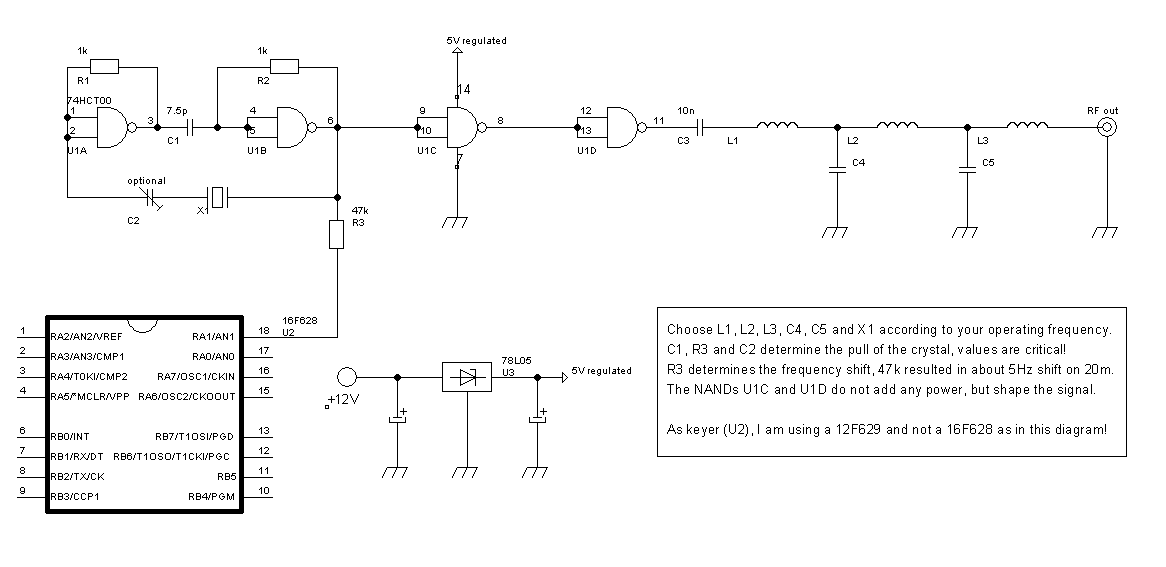
First revision
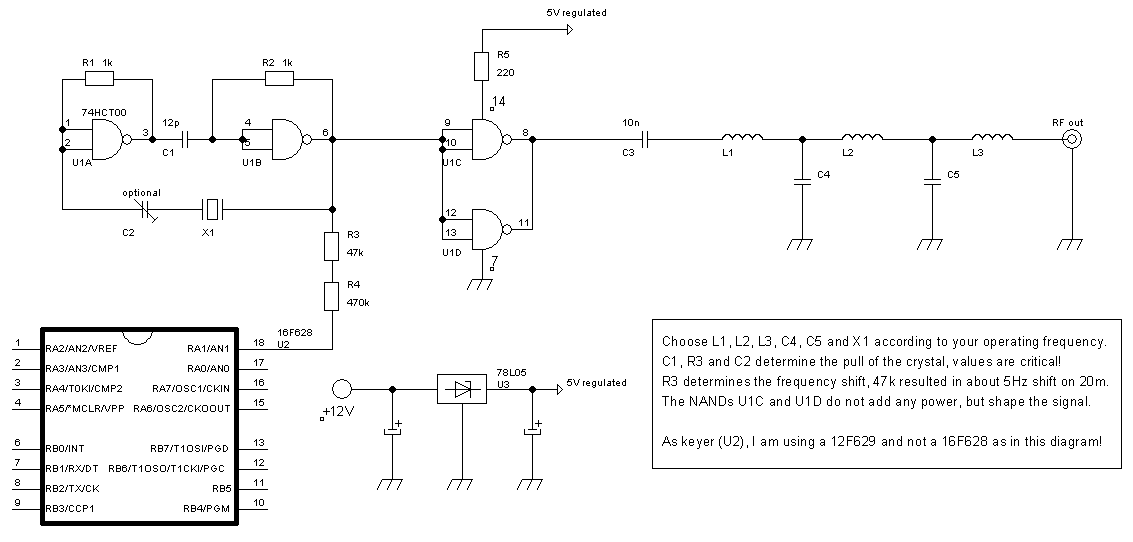
Superhet XTAL Combinations
The following list is rather old, however, it wont be outdated as long as we keep out frequency bands.
Crystals for QRP and homebrew
The presented lowcost standart crystal frequencies are selected for the usage in superheterodyne sideband transceivers (receivers). For extension to this list, look at 7N3WVM's homepage. Makoto, in addition to his list, shows a block diagram for superhets, and provides excellent information about VXOs. The frequencies in this list need in some cases multiplification with a given factor M. The intermediate frequency if is shown for superhet designs. Crystals for the intermediate frequency have to be fundametals for easy to build SSB/CW ladder filters. Where the frequency multiplication factor equals 1 you might swap VXO and filter frequencies, depending on your junk-box/requirements.
| HAM band | VXO [MHz] | M | if [MHz] | QRG [MHz] |
| 160m | 9.8304 | 1 | 8.000 | 1.830 |
| 80m | 6.000 | 1 | 2.4576 | 3.542 |
| 6.400 | 1 | 2.4576 | 3.942 (*) | |
| 8.000 | 1 | 4.4336 | 3.566 | |
| 8.000 | 1 | 4.500 | 3.500 | |
| 8.867238 | 1 | 5.0688 | 3.798 | |
| 9.8304 | 1 | 6.000 | 3.830 (*) | |
| 9.8304 | 1 | 6.144 | 3.686 | |
| 10.000 | 1 | 6.400 | 3.600 | |
| 11.000 | 1 | 7.3278 | 3.627 | |
| 11.0592 | 1 | 7.3278 | 3.686 | |
|
|
|
|
|
|
|
|
14.7456 | 1 | 11.000 | 3.746 |
| 22.1184 | 1 | 18.4321 | 3.686 | |
| 40m | 4.000 | 1 | 3.2768 | 7.277 (*) |
| 4.9152 | 1 | 2.097152 | 7.012 | |
| 4.608 | 1 | 2.4576 | 7.066 | |
| 5.0688 | 1 | 2.000 | 7.069 | |
| 11.059 | 1 | 4.000 | 7.059 (++) | |
| 12.000 | 1 | 4.91403 | 7.086 | |
| 17.73447 | 1 | 10.700 | 7.035 | |
| 22.1184 | 1 | 15.000 | 7.118 | |
| 30m | 6.5536 | 1 | 3.579545 | 10.133 |
| 6.144 | 1 | 4.000 | 10.144 | |
| 7.3729 | 2 | 4.608 | 10.138 | |
| 7.3729 | 3 | 12.000 | 10.118 | |
| 14.31818 | 1 | 4.194304 | 10.124 (+) | |
| 14.7456 | 1 | 4.608 | 10.138 | |
| 22.1184 | 1 | 12.000 | 10.118 | |
| 20m | 6.400 | 5 | 17.73447 | 14.265 (?) |
| 9.8304 | 1 | 4.194304 | 14.025 (+) | |
| 6.5536 | 5 | 18.432 | 14.336 | |
| 8.000 | 1 | 6.144 | 14.144 | |
| 9.216 | 1 | 4.9152 | 14.131 | |
| 9.216 | 1 | 5.000 | 14.216 | |
| 9.000 | 1 | 5.0688 | 14.0688 | |
| 9.005 (**) | 1 | 5.0688 | 14.074 | |
| 9.216 | 1 | 5.0688 | 14.285 | |
| 9.216 | 1 | 5.120 | 14.336 (+++) | |
| 9.8304 | 1 | 4.4336 | 14.263 | |
| 10.000 | 1 | 4.000 | 14.000 | |
| 10.000 | 1 | 4.096 | 14.096 | |
| 10.000 | 1 | 4.194304 | 14.194 (+) | |
| 11.000 | 1 | 3.2768 | 14.277 | |
| 9.216 | 1 | 4.9152 | 14.131 | |
| 11.0592 | 1 | 3.2768 | 14.336 | |
| 16.000 | 1 | 1.8432 | 14.157 | |
| 17.73447 | 1 | 3.579545 | 14.155 | |
| 22.1184 | 1 | 8.000 | 14.118 | |
| 24.000 | 1 | 9.8304 | 14.170 | |
| 17m | 12.000 | 1 | 6.144 | 18.144 |
| 14.000 | 1 | 4.096 | 18.096 | |
| 22.000 | 1 | 3.9321 | 18.068 | |
| 22.1184 | 1 | 4.000 | 18.118 | |
| 15m | 6.400 | 5 | 10.700 | 21.300 |
| 6.5536 | 2 | 8.000 | 21.107 | |
| 8.000 | 2 | 5.0688 | 21.069 | |
| 16.000 | 1 | 5.0688 | 21.069 | |
| 6.5536 | 4 | 5.0688 | 21.146 | |
| 7.3728 | 2 | 6.5536 | 21.298 | |
| 14.31818 | 2 | 7.3728 | 21.264 | |
| 14.7456 | 1 | 6.400 | 21.146 | |
| 14.7456 | 1 | 6.5536 | 21.299 | |
| 25.000 | 1 | 3.9321 | 21.068 | |
| 25.000 | 1 | 3.6864 | 21.313 | |
| 15.360 | 1 | 6.000 | 21.360 (+++) | |
| 25.000 | 1 | 3.579646 | 21.420 | |
| 12m | 10.000 | 2 | 4.9152 | 24.915 |
| 30.000 | 1 | 5.0688 | 24.931 | |
| 20.000 | 1 | 4.9152 | 24.915 | |
| 10m | 6.144 | 5 | 2.4576 | 28.262 |
| 6.144 | 3 | 9.8304 | 28.262 | |
| 6.144 | 3 | 10.000 | 28.432 | |
| 6.5536 | 2 | 15.360 | 28.465 | |
| 6.400 | 3 | 8.867238 | 28.067 | |
| 6.400 | 3 | 9.216 | 28.416 | |
| 6.5526 | 3 | 8.867238 | 28.538 | |
| 6.5526 | 5 | 4.433619 | 28.334 | |
| 22.1184 | 1 | 6.000 | 28.118 | |
| 16.384 | 1 | 12.000 | 28.384 | |
| 6m | 8.867238 | 5 | 6.144 | 50.479 |
| 9.216 | 5 | 5.0688 | 51.149 | |
| 9.216 | 6 | 5.0688 | 50.227 | |
| 9.216 | 6 | 5.000 | 50.296 | |
| 9.216 | 6 | 4.9152 | 50.381 | |
| 14.7456 | 4 | 8.867238 | 50.115 | |
| 18.432 | 3 | 5.0688 | 50.227 | |
| 18.432 | 3 | 5.000 | 50.296 | |
| 18.432 | 3 | 4.9152 | 50.381 | |
| 60.000 | 1 | 9.216 | 50.784 | |
| 60.000 | 1 | 8.867 | 51.133 | |
| 60.000 | 1 | 9.8304 | 50.170 | |
| 14.000 |
2 | 22.1184 | 50.118 | |
| 2m | 14.000 | 10 | 4.000 | 144.000 |
| 14.000 | 10 | 4.096 | 144.096 | |
| 14.000 | 10 | 4.194 | 144.194 (+) | |
| 9.216 | 15 | 6.000 | 144.240 | |
| 9.216 | 15 | 6.144 | 144.384 | |
| 17.73447 | 8 | 2.4576 | 144.333 | |
| 8.867238 | 16 | 2.4576 | 144.333 | |
| 14.7456 | 10 | 3.2768 | 144.179 |
(**) CB-crystal 27.015 MHz
(+) here is a mixer xtal available at 4.194812 MHz
(++) combination found by Juanjo - EC5ACA
(+++) combination found by Klaas - PE1MJZ
(?) questionable, intermediate frequency rather high
This list cannot be complete, and it is not claimed to be complete. If you feel the wish to respond, add new xtal-pairs, or send donations ... please do not hesitate to do so. But, remember that those crystals should be really inexpensive.
QRP Transmatch ATU
A QRP Transmatch ATU
Introduction
In regard of my contemporary personal situation, I decided to do something reasonable to come to new thoughts... Despite the title, this following device is not for qrp use only, as my experience soon proved. It was possible to match a 2m vertical wire at 80m with no sparks occuring up to 50W RF. But... on air experiences will show up later...Circuit diagram
First approach, the ultimate transmatchNext try, the SPC transmatch
Circuit description
For theoretical background I would like to point the reader to the common standart literature as the famous RF textbook of Meincke and Gundlach, or comparable other readings. The first approach was thought as an experiment to understand the so called ultimate transmatch (UT, first proposed by Lew McCoy). In principle I would recommend this design, also driven by my practical experience. It delivers good matching with moderate bandwidths. Besides that this design might have a slightly higher loss.Apart from what I have written in the first version of this text, all the parts were fine to build a UT-ATU, but the rotary switch, and my attention at this time, fooled me. Thinking I got a 1x12 switch, I soldered the wires fitting this type. A few days later, reading a catalogue, it was clear, that the built in think is a 2x6 type. An additional switch cured the "problem". So, the finally completed ATU now is an UT.
Advantages: very smooth tuning even at the more critical frequencies like 29.690MHz, our local (Hamburg, Germany) repeater. QRO in this design seems not to be harmful at all, 120W RF on all available bands (40m to 10m) were matched to a 2m wire as well as to a 10m wire w/o sparkling ATU ;-)
As a comparison, I chose the series-parallel capacitance transmatch (SPC), for the reason that it took me just two leads reconfigured to convert on to another. Formerly I also planned to test the standart transmatch, but the overwhelming wish to get on air forced me to stay at the simple - to - obtain - by - the - most - simple - modification - design (smiley!). Disadvantages in this design (agn, have a glance to the textbooks) are the extreme narrow bandwidths and the low QRO ability (high Q).
What to chose if money plays no role? Certainly I would go for the UT, with two two-gang vernier capacitors at 1nF max (in both sections) and a roller inductor... if... but... it's all built from the junk-box.
Parts descriptions
The capacitors are the simple part. I just found them on the bottom of my junk box. They look like they were intended to go into AM broadcast receivers. In either design one has both sections wired in parallel. The inductor, the tricky thing in matching units with variable inductance. For the body I found an old pill container with a diameter of 4cm. The coil is then wound on this with 60 windings of 1mm enameled copper wire. The first 36 windings tight together, the rest with increasing wire to wire distances to the upper (hot) end of the coil. Tabbings are located at the windings 19, 28, 37, 42, 47, 50, 53, 55, 57, 58 and 59 for use with a 12 positions rotary switch shortening to ground, as I thought... In reality it's a 2x6 with an additional switch.SWR indicator
My good friend Rico (DF2CK) had the heart to donate a PCB reflectometer to me. To make one yourself, have a look at Harry's (SM0VPO) Homebrew Page. Can't remember the way Harry did the rest, I added a 47k potentiometer for sensitivity adjustment, and a 4k7 suppression resistor to the forward meter, for reasonable reading during the tuning process. The meter itself is a standart stereo VU-meter, found in obsolete tape recorders (other superb parts could be found there likewise). Usage: Highest sensitivity and lowest reasonable RF power to start with. During the tuning you certainly will increase the RF power the closer you are to good matching. With CW, your favoured mode ;-), you then automaticaly will have the correct sensitivity setting during QSOs. For SSB contacts, you should keep in mind to reduce the sensitivity close to zero after tuning. The clicking meters will remember you to do so elsewise. Weak nerves would make you think of a sparkling capacitor, hi!Tuning procedure
Yes, I know, that's common knowledge... but... we have two designs in this report. My experience was that the both designs have a contrary behaviour. Tuning with the UT: Fiddle during RX with all the buttons to get the loudest noise. You're allready close! Next is done with a little RF applied, power depending on the band, little fine tuning, done! QSO! Tuning mainly was done during RX. On the other hand I experienced that the RX maximum must not be the minimum in SWR.Tuning with the SPC transmatch: More difficult, because of the narrow bandwidths. Set your transmitter to a few tens of milliwatts to find a C-L-C combination where the reflected power is halfways acceptable. Now the game begins! By slightly in/de-creasing certain capacities and inductivities find a good match. You will notice, it's much more complicated to find a good match, as the SPC transmatch with the given parts will provide exactly one for a specific aerial<->QRG combination.
Experiences
Clearly the SPC transmatch easily is able to match a 2m wire to 3.5Mhz w/o any problem, but, whatever band you're QRV on, watch the reflected power... Using the SPC transmatch, you will have to retune every tens of kHz. The UT give, as mentioned above, broader bandwidths. With both designs it now is possible to match a 2m wire to all bands (even 160m, although this makes no sense at all). It was easy to confirm the statements given in the literature about the behaviour of the presented matching networks. So, before you start soldering, think about what kind of aerial you want to match, and have a closer look to the textbooks. The opinion given there is that the UT can better handle inductive loads while the SPC transmatch is performing smoother on capacitive loads.Photographs
The inductor. I know, does not look extremely professional...Box, partially assembled. The capacitors are glued to PVC insulators (using hotglue). Also the pill container inductor is glued to the box. On the left side, you can see the reflectometer PCB.
Box, completed. The knobs for the capacitors nowadays are replaced by larger ones, depending on the settings your hand has a strong influence to the capacities.
Simple 70cm GP-antenna
70cm Ground Plane Antenna
Materials used
- about 90cm of 1mm silver steel rod
- one luster terminal with at least two
- 50Ohms coax cable
- glass fibre mast
lead guides beeing able to carry 2mm leads
Construction & Design
Sketches or drawings are IMHO not necessesary because of the extreme simplicity of the "design". Cut 19cm off the rod, and bend 2cm at one end by an angle of 90°. This will be the radiator, 17cm straight up in the air. It will directly go in one whole of the luster terminal. Watch out, that the terminal´s skrews are pointing downwards, elsewhise you will later have problems with water and corrosion. The radials are made of two rods with a length of 34cm. Stick both through the other whole of the luster terminal, centered. You might now bend each rod to an angle of 90°, with the luster terminal in it´s centre. To give it the correct feed-point impedance the radials should be twisted slighly downwards.Connect the coax cable to your little aerial, using again the abilities of the terminal. BTW, I used RG174 (lossy!) for the last meter, to reduce the weight.
In the middle of modern luster terminals there are wholes, to mount the terminal wherever it should go to. This whole (3mm) is perfect to stick the mast through. At the very top mine has a diameter of 2.8mm. This makes the ground plane to rest only 12cm below the top.
Alignment
In principle exactly the same way as for any other antenna, you have built up to know. Find it´s resonance, and cut off as much as needed to obtain the desired resonance frequency. The SWR can be improved by variing the downward angles of the radials.Experience
I am happy! Whenever the reflection I have to use with my indoor HB9CV-antenna does not provide nice signals, I can errect the glass-fibre mast with the ground plane, and establish a stable link to my local digipeater (running the transceiver´s lowest power setting). Besides that I could hear a lot more phone repeaters than before. The only pitty is, that I do only posses one such mast... so, no shortwave during packet, or vica versa :-(Photographs
Taken at 31.12.2000, the last day of the second millenium... Various angles and views...2m J-Pole Antenna
Simple J-Pole for the 2m band
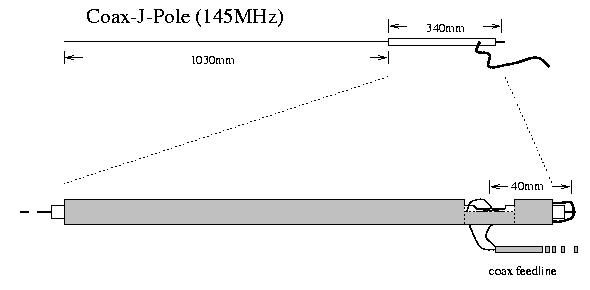
To adjust the SWR you will have to "play" with the 40mm distance between the coax feed and the braid -- inner conductor connection. I could obtain a SWR of 1:1 at 145MHz. All together in my favourite material, PE tubing, with a simple tripod this makes my 2m standby aerial.
Photograph taken on my balkony.
2m Lightweigth 4 Element Yagi
Lightweight 4 Element Yagi for 144.3MHz
Materials and description
The choice of the materials used should be a compromise between weight and robustness. So this ended up at 1.4mm stainless steel rods and 11mm PE installation tubing as used by electricians. For the beam to be portable, it is convenient to spit the boom into two pieces. The ideal solution (in my mind) is to used the ends for the middle of the boom, as they are already made to stick into eacs other. I drilled a whole through the joint boom at the overlapping region. One now can kill two birds with one stone by impaling the yagi at this specific drilling to hold the boom parts together and the antenna to the sky (see sketch). The elements sticked through drillings in the boom and fixed by hotglue. The driven element is tuned by sliding the rods in and out, until matched. Fixed then by luster terminals. The driven element is built similarly to the 3-element-yagi presented in the ARRL handbook 2000.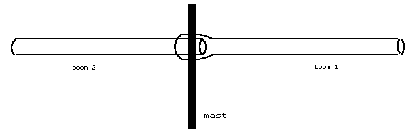
Dimensions
| Element | Material | Dimensions | Dist. to reflector |
| reflector | 1.4mm steel rod | 1035mm | 0mm |
| driven element | 1.4mm steel rod | 2x50mm | 416mm |
| 1st director | 1.4mm steel rod | 936mm | 831mm |
| 2nd director | 1.4mm steel rod | 926mm | 1290mm |
| boom 1 | 11mm PE tubing | 700mm | -- |
| boom 2 | 11mm PE tubing | 700mm | -- |
Simulation
The dimension of the driven element was measured after SWR-tuning. The construction allows easy tuning as the element is fixed using a luster terminal. -------------------------------------------------------------------------------YAGIMAX 3.0 CALCULATION OF 4 ELEMENT YAGI
ULTRA LIGHT YAGI AS BUILT
07-20-2000
13:37 FILE: DL1GSJ_R.INP
-------------------------------------------------------------------------------
ELEMENT: LENGTH (Cm.) SPACING FROM REF. (Cm.) ELEMENT DIA. (Cm.)
Reflector: 103.5000 0 0.14000
Driven Ele.: 99.0000 41.6000 0.14000
Director #: 1 93.6000 83.1000 0.14000
Director #: 2 92.6000 129.0000 0.14000
-------------------------------------------------------------------------------
Normalized Radiation Resistance at 144.300 mHz is 55.71 Ohms
-------------------------------------------------------------------------------
FREQ (mHz) GAIN (dBi) F/B (dB) IMPEDANCE (ohms) VSWR
144.000 9.09 12.04 49.69+j14.17 1.04
144.050 9.09 12.07 49.89+j14.43 1.03
144.100 9.09 12.09 50.09+j14.69 1.03
144.150 9.10 12.12 50.29+j14.94 1.02
144.200 9.10 12.15 50.48+j15.19 1.01
144.250 9.10 12.17 50.67+j15.44 1.01
144.300 9.10 12.20 50.86+j15.68 1.00
144.350 9.10 12.23 51.05+j15.92 1.01
144.400 9.10 12.25 51.24+j16.15 1.01
144.450 9.10 12.28 51.43+j16.38 1.02
144.500 9.10 12.31 51.61+j16.61 1.02
144.550 9.10 12.33 51.79+j16.83 1.03
144.600 9.10 12.36 51.97+j17.05 1.04
144.650 9.10 12.39 52.15+j17.26 1.04
144.700 9.10 12.42 52.32+j17.47 1.05
144.750 9.11 12.45 52.50+j17.68 1.05
144.800 9.11 12.48 52.67+j17.88 1.06
144.850 9.11 12.51 52.83+j18.08 1.06
144.900 9.11 12.54 53.00+j18.27 1.07
144.950 9.11 12.57 53.16+j18.46 1.07
145.000 9.11 12.60 53.32+j18.64 1.08
-------------------------------------------------------------------------------
Photo
Yagi-Uda antenna held in the evening sky of HamburgExperience
Immediately after tuning the antenna went into the sky. Fortunately it was weekend, so that a few station were operating 2m SSB. Good reports and a good directional effect made me believe the antenna is worth to be presented. Without having planned to do so, I made several QSOs during the scandinavian activity contest with 10W pep RF output. Like the magnetic loop for 2m the beam is lifted in a hight of 3-4m above the roof. For sure this does only work when there is no wind, as the beam sticks to the telescopic mast where this is 4mm in diameter only.2m Magnetic Loop Antenna
Magnetic Loop for the 2m band
Materials and description
The whole choice is copper. This loop is made of 50cm of 4mm "soft" tubing. The capacitor of two 1mm circular plates with about 3cm diameter torch-brazed to the loop conductor. The coupling loop is made of 1mm solid wire and held by a luster terminal. Tuning is done by bending the loop to in- or decrease the capacitor plate's distance.The whole thing is than strapped to a bar of plastics with a tiny whole in it's center of mass to be skewered to my fiberglass telescopic mast. Meanwhile I built a second magnetic loop for this band, made of an old used UHV (ultra high vacuum) ring gasket and a small tube capacitor. The gasket is made of 1mm copper with an outer diameter of 120mm and an inner diameter of 100mm. The capacitor is connected by screws and the coupling loop by a luster terminal screwed on the gasket. A photograph is taken, but not yet available, sri...
The main concern with copper is, that it corrodes. Remember, skin effect... Some finish should be applied to protect the conductor's surface.
Experience
Such kind of omnidirectional antenna gives the possibility to be QRV with horizontal polarisation, as commonly used for the CW and SSB section of the 2m band. This actual design shows a 1.3:1 bandwidth of about 150kHz, centered to 144.200MHz. The SWR on the lower end of the CW section still allows transmitting. The aerial gave good results on the local rag chew at 144.350MHz (using 10W pep) with the clear advantage of the directional diagram of a "lying" magnetic loop.Do not believe people telling you that this kind of antenna does not work for higher frequencies. It will not make you QRV from the basement, but held up in the air, to the same hight you would lift a beam to, it performs really satisfatory.
Photographs

6m omni-directional antenna
6m omni-directional antenna
(horizontally polarised)
Concept
The design follows the idea of the so
called
"CobWebb-Antenna" for the high frequent shortwave bands. The basic
concept of this idea appears to be a folded dipole made of
twin-lead which is
then bend in a circle of rectangle. Basically the rectangle seems to be
the simpler option.
The folded dipole itself and the way to calculate it's dimentions is well described in the literature, i.e. Rothammel. The idea is to make this dipole from standart twin-lead used for electrical home installations. The remaining problem: What is the velocity-factor of you twin-lead.... I guess you will have to measure it (should not be a big deal when following one of the many articles on that topic).
The folded dipole itself and the way to calculate it's dimentions is well described in the literature, i.e. Rothammel. The idea is to make this dipole from standart twin-lead used for electrical home installations. The remaining problem: What is the velocity-factor of you twin-lead.... I guess you will have to measure it (should not be a big deal when following one of the many articles on that topic).
Dimensions used for 50.15 MHz
| Material used: |
2 x 0.75
mm² |
| Total length of twin-lead: |
293.2 cm |
| Length of one
dipole leg: |
146.6 cm |
| Distance feed to short: |
88 cm |
There certainly is some room for optimisations of the dimensions given above... any volunteers?
Photographs
... say more than 1000 words ...Experience
Smooth SWR about 1:1.1 measured by my IC703. The beacon PI7SIX (JO22nc to JO22eb) tuned in nicely...My Take on the Rockloop
Rockloop Antenna @dl1gsj
A magnetic loop made just of wire?
Years ago I started experimenting on magnetic loops & Co; I like the idea of narrow resonant aerials. When I saw the rockloop I never believed it might work (Ohmic resistance of the wire). Nowadays, travelling around a lot, I was looking for some antennas fitting my luggage. Again I found W9SCH's rockloop.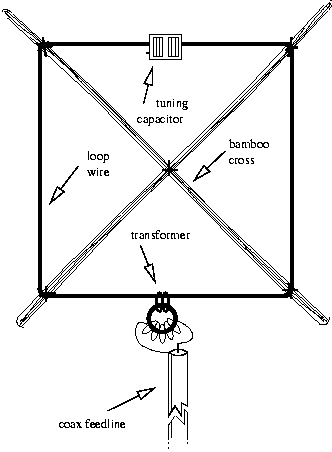
Thoughts to the original design
If I interpreted the original design correctly, the rockloop is constructed of a radiator wire, a transformer and a tuning capacitor. The transformer, as implied in G3YCC's description , seems to be made of a different (at least another) wire than the radiator. Following the calculations that can be done on magnetic loop antennas, one knows about the extremely low radiation resistance of these loops. This requires the total Ohmic resistances to be as low as possible. To gain the lowest possible Ohmic resistance, I decided to use a larger dimensioned toroid core to fit five windings of the radiator wire on it (no solder joints, lower losses).Materials
- about 4m insulated copper wire
- 2 bamboo pole 1.2m long
- toroid core of your choice
- variable capacitor
- bunch of cable ties
- insulated wire for the primary transformer winding
- BNC connector or coax cable (or both...)
Dimensions
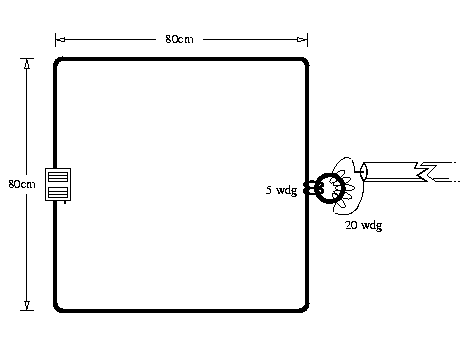
The four sides should have a length of 80cm, this will enable you to resonate the antenna up to the 15m band. If there are needs for the higher bands one should go for shorter sides. The transformation ratio was suggested by W9SCH. The 5 windings on the secondary side will influence the overall inductance of the loop...
Transformer
Everything is said already. Just have a look at the photograph. I have to admit, there certainly are better ways to mount the BNC connector...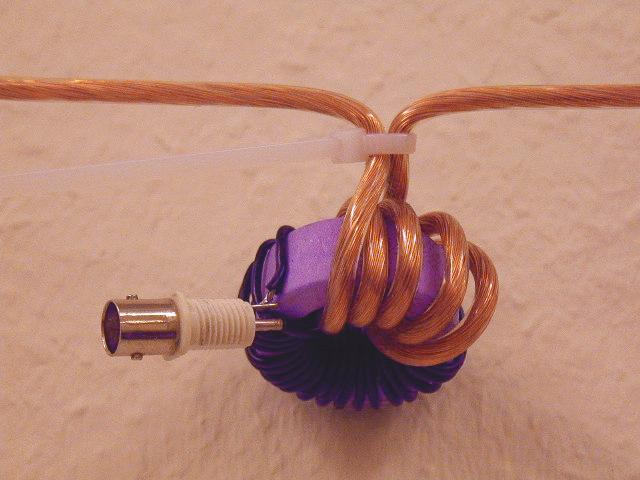
Tuning Capacitor
We are going QRP with this aerial anyhow. I found this one in a old BC-RX (my favourite source for these things). It helps if the capacitor has two identical sections. Feeding just the stators will on one hand leave the rotator and therefor the chassis w/o RF on the other it double the voltage rating. The solder joints should be as solid as possible (remember the resistance story). I used a 80W iron to solder the loop wire directly to the stators.Overall View
Showing pictures, it might be reasonable to show the whole thing. What I found helped, so there ist a shelf's backside steelcross used to give support for the bamboo rods. This will disappear soon... making place for some more cable ties. Please excuse the poor light quality on this one, was made on a business trip in the middle of the night.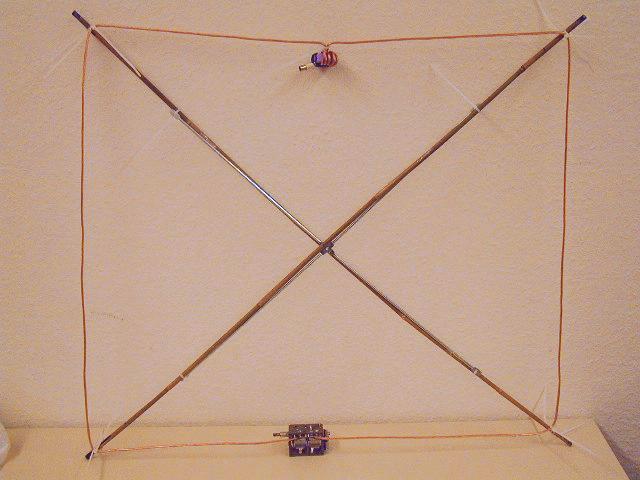
Experience
The tuning range is huge. I observe resonance between 5 and 22MHz. Even though it tunes on the 40m band, I believe transmitting there might not make that much sense - radiation efficiency would not be that great. I used the lower range to listen to broadcast.First QSO on 20m during this business trip (Germany) resulted in a report of 579 from Hungary using 2W PSK31 (w/ FT817). At this time the antenna was hanging on a wardrobe (indoors, as you expect). The room was located at the ground floor of a steelwork office building.
Some news on my rockloop
I went out for some shopping, and that's the result (well, not the Al-boom on the floor):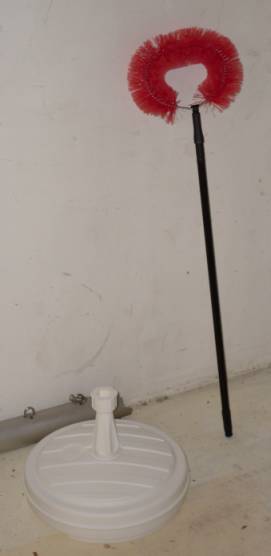
Thus, here's a very very cheap and easy solution. The sunshade stand cost me less than 4 Euros, the spider web broom was about 4 Euros.
Let's see what the mod is like. The broom itself can be easily separated from it's telescopic stick. Simply pull (carfully) on the steel bits. Twisting the stick slightely helps a lot. The result would be something like this:
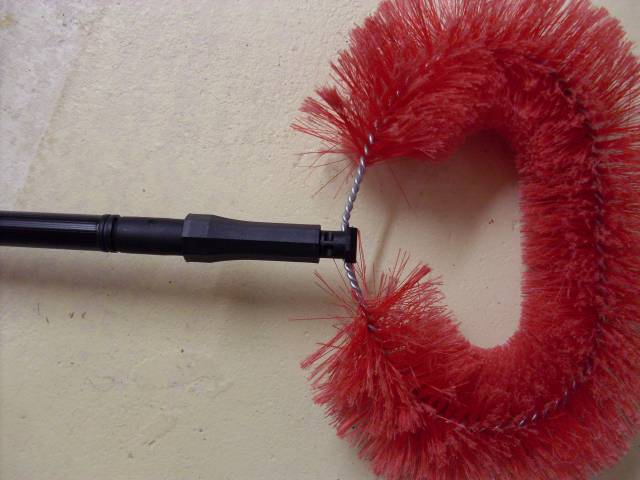
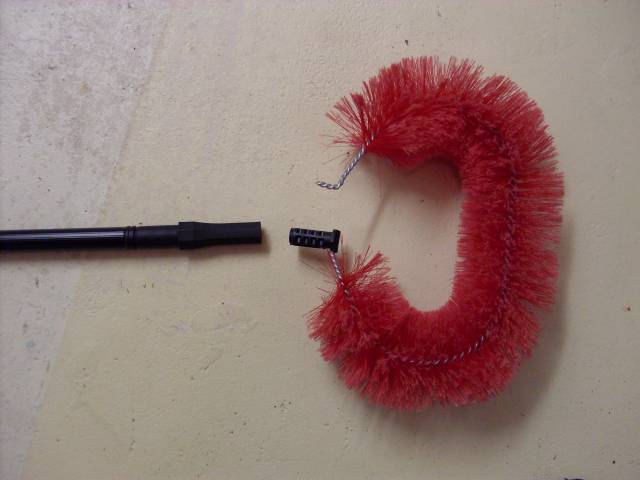
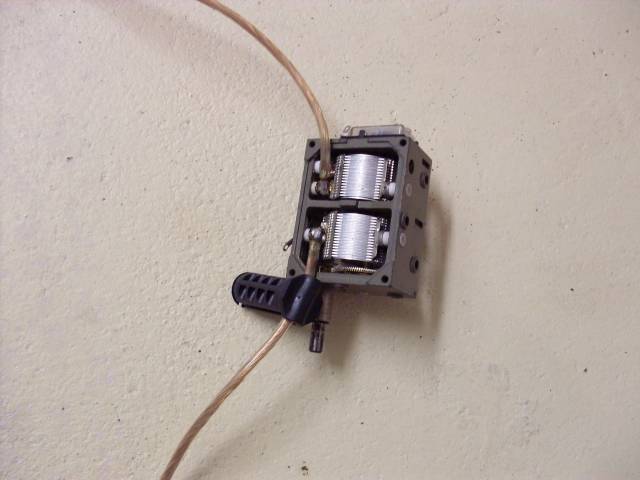
In the sequence of events, the plastic bit will mysteriously find it's way back home into the business end of the broomstick. As such:
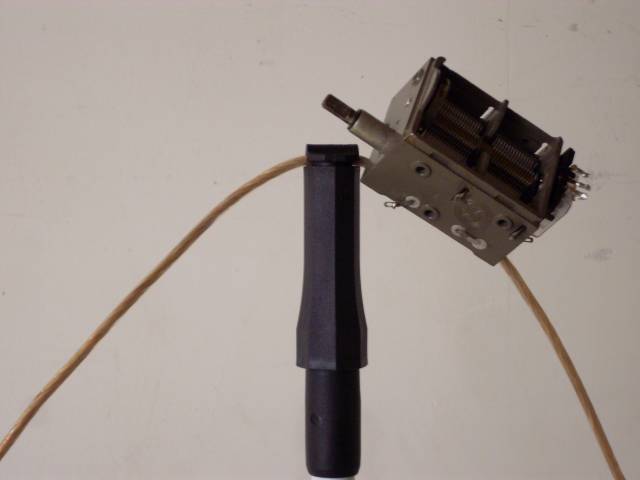
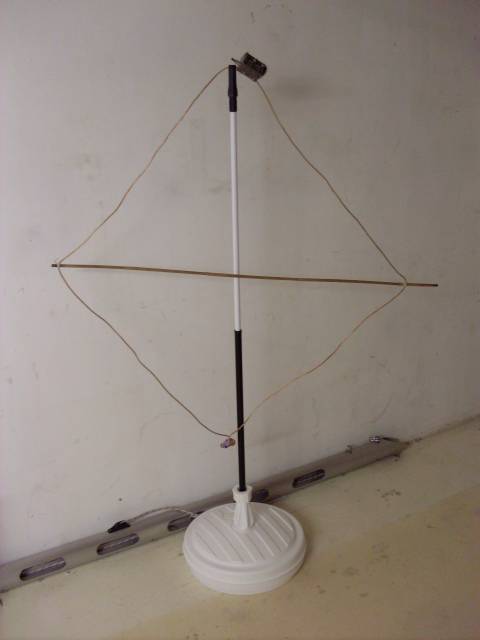
Hentenna for the Magic Band
Hentenna for the 6m band
Dimensions
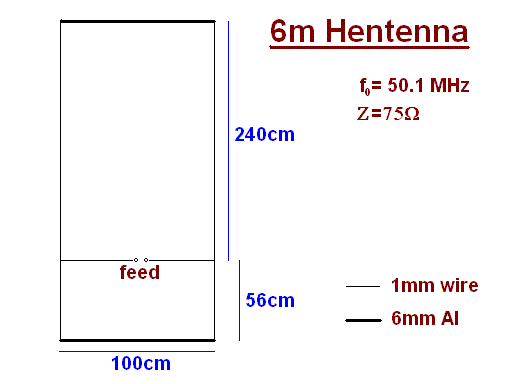
Simulation using mmana
First image showing the current distribution on the aerial, the second one the directional diagrams. The "real" ground settings were used, with the Hentenna "placed" in a hight of about 5m.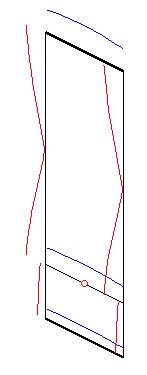
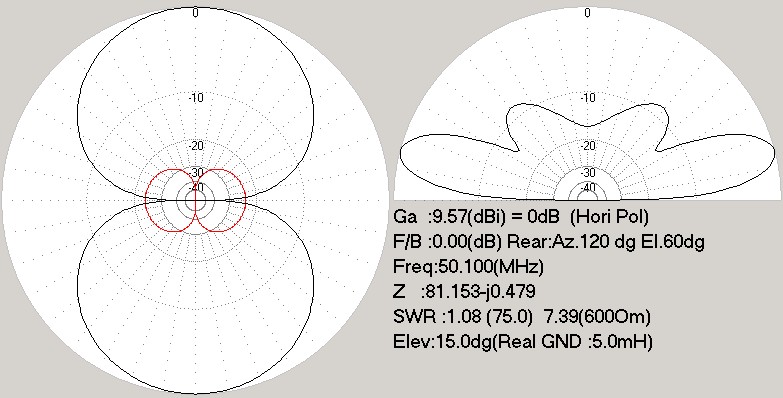
Normal and 3d photograph
This is what it finally looks like...
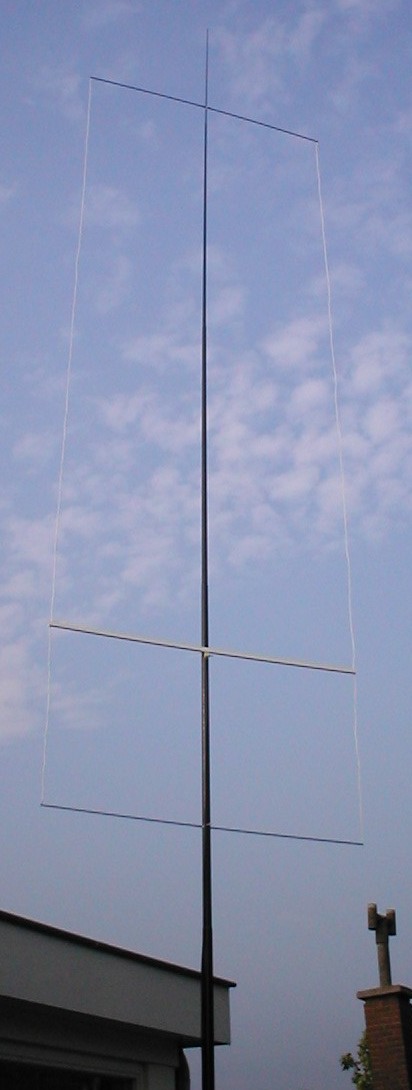
If you happen to own red/green glasses for
viewing 3d-images:
Hints & Experiences
The feeding section perfectly fits into a small (13x13mm²) 1m long cable channel. The cable channel suffers from a couple of holes drilled in it's sidewall in order to guide out the feeding leads. A luster terminal is finally applied to connect the coax cable. In a former version a bamboo pole was used; doesn't look as nice, but less work to be done...You might practice some inventiveness in order to connect the 1mm cables to the end of the aluminium poles... I squeezed the end of the pole a little bit with pliers and cut a 4mm thread into the inner surface of the Al pipe.
Used it as shown above. The aerial gave nice instantanious results (beacons & Co.), even though that the band was pretty dead, I managed to have some QSOs with reasonable results. My impression is, that the Hentenna performs better than my commercial Al-pipe dipole. Moreover it is easier to transport and/or store anyway.
The total costs were about €10.- w/o the feeding RG58 --- I known, 50Ohm cable to a 75Ohms aerial...
2m omni-directional horizontally polarized antenna
2m omni-directional antenna
(Squarooka - squared bazooka)
Concept
Sort of similar to the one of the 6m
omni. Instead of using twin-lead, this design makes use of a more or
less regular double bazooka antenna (coaxial dipole). Your attention
shall be drawn to the available standart literature, such as Rothammel.
In order to "compute" the dimension, Karl Rothammel mentioned that the total length of the dipole shall be 95% of the free-space wavelength. The short-circuit bridges (closing the folded dipole) are to be placed at a distance-fraction being equal to the velocity factor of the coax cable used, which will be 66% using RG-58 or RG174.

the horizontal directional diagramm

and for completeness, the vertical diagram too
In order to "compute" the dimension, Karl Rothammel mentioned that the total length of the dipole shall be 95% of the free-space wavelength. The short-circuit bridges (closing the folded dipole) are to be placed at a distance-fraction being equal to the velocity factor of the coax cable used, which will be 66% using RG-58 or RG174.
Some Simulations....
No sofisticated simulations have been done on this aerial... Just to give a short impression what can be expected, a very rough simulation using "real" ground setting with an antenna height of 9.5m (corresponds to a height gained by a DK9SQ "fibreglass telescope tower").
the horizontal directional diagramm

and for completeness, the vertical diagram too
Dimensions used for 144.350 MHz
Based on a free-space wavelength of:
( 299.79 / 144.35 ) m = 2.0768 m
Have a closer look... and identify my favourite materials. The cross is made of some strange PVC profile this time. You might also recognise one short-circuit bridge on the front right of the square.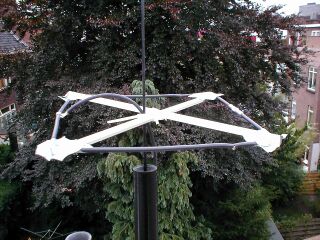 |
 |
Construction
The difficult part in building a double bazooka antenna is cutting the coax. More precisely: NOT cutting throught vital parts of the coax cable, i.e. the braid.As shown in the image below, the outer (black) insulation and the shield have to be cut, preferably w/o cutting into the dielectric...

This is the way I usually do these sort things:
- scarsify the insulation with a sharp knife at the first side of the feed point, taking care not to cut through the black polymer
- bend the cable at the cut, which will cause the insulation to torn apart precisely at the cut
- scarsify the insulation with a sharp knife at the second side of the feed point
- cut in a straight line from the first to the second edge and peel
off the insulation
- wind one turn of 1mm solid copper wire (approximately 1cm long) around the shield on each side of the feed region adjacent to the outer insulation
- twist the ends of the copper wires with pliers in order to firmely press the shield onto the dielectric
- cut the shield in the middle of the feeding section, taking care not to cut into the dielectric
- bend the shielding portions over the copper winding
- solder shields and copper winding together
- make sure that no filament of the shield remains between the two feed points
- ouffff!!!!!
Here is the way to proceed:
- take a knife and cut the insulation and the shield of the coax cable precisely at the position of the bridge, this time taking care to cut the dielectric too by leaving the braid unhurt (may not cutting the dielectric completely down, but leaving a little bit uncut)
- bend over the coax cable at the cut as far as possible, this will
lay open the braid and hopefully tear the remaining dielectric apart
(if the last did not occur, whittle the last layer of dielectric away)
- here comes the copper wire again, push some below the braid
(might
be tricky) and bend it over the braid - this will make the
short-circuit between shield and braid
- carve some insulation off the rims of the cut
- solder the braid to the copper wire
- bend back the coax into a straight line
- solder the copper wire to the shield, both rims must have good contact
- tataaaa!!
I used duck tape to fix all together, including the joint of the dipole legs opposite the feed point (visible on the above photograph). Looks ugly, builds quickly.... good luck!
Experience
It was built just the day before this text came to see the cyber-world's light... therefore there was no time at all to do more than just an RX check-up. PI7CIS (JO22dc) tuned loudely in my Belcom LS-202E (which is not really surprising, since the beacon is just a couple of kilometers apart from my place in JO22eb). By turning the mast around a slight volume change could be heard, even though the S-meter reading did not really change.Second rx-test (13.Sept.2003), with the FT817 this time, gave S8 on PI7CIS and S1 on GB3VHF (JO01dh) and PI7PRO (JO22nc). Besides the beacons the band was quiet.... therefore still no tx-test.
Subscribe to:
Comments (Atom)
